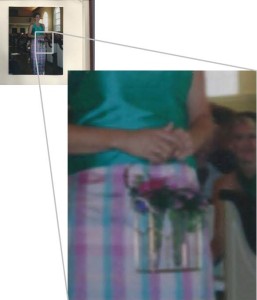Sometimes, I wonder if my friends actually like me or if they only keep me around because I’m a ringer for the science questions at bar trivia night.
Case in point: the bridesmaid dress.

There hadn’t been a plaid this loud at a country club since Al Czervik invaded Bushwood.
Let me preface this story with the caveat that I adore my college girlfriends. They put up with my crap for 4 years of college and even pretended to understand what I was talking about for 5 1/2 years of grad school. Along with my mother, they were all relieved when I took the museum job and they could finally explain what the hell I do for a living. We have the kind of unfailing bond that has seen us through the lumps and bumps of nearly 20 years and will continue to do so for decades to come. It’s the kind of bond that makes you do stupid things. So when Anna asked us to wear plaid at her wedding, we didn’t hesitate.
Love is a funny thing.
There are some gorgeous plaids out there in the world. Case in point: Burberry. Cozy, geometric combinations of camel, white, black and red that can be alternately sweet and edgy. A lot of good can come of plaid when used responsibly. This was not one of those of plaids. This plaid had no business being made into a dress. It barely had business masquerading as an upholstery fabric. (I swear, a bolt of fabric from the Ethan Allen 1992 home collection went missing and resurfaced at this wedding.) It was hot pink and turquoise, for God’s sake. As if that weren’t hateful enough, the fabric was in dupioni silk.
I can hear you now: But what’s wrong with dupioni silk? It’s a gorgeous high-end fabric.
Yes, yes it is. But here’s the rub: it’s also slightly iridescent. This has to do with differences in the silk fibers that are woven together to make the fabric.
The fibers going in one direction of the weave (called the weft) are made from thick, uneven silk fibers that result when two cocoons are so squished together that the silk worms just spin their fibers intertwined together. The threads woven perpendicular to the weft (called the warp) are long and smooth. Now, think about a mirror: a smooth surface lets the light reflect off of it and makes it shiny. Rough surfaces scatter the light and they appear dull. Right? Now, back to the silk: the combination of the smooth and rough makes the finished fabric catch the light in interesting ways and it appears to have a sheen. This is all fine and good. But then you use this technique to make a plaid dress fabric and all hell breaks loose.
As a bridesmaid, my job was to be a good team player, don the dress and look happy about it. I wore my plaid like a champ. I didn’t even complain (within earshot of the bride) about the strange baskets of flowers we carried in lieu of bouquets. The trouble started when the cameras came out. The unassuming plaid dupioni becomes day-glo when a flashbulb hits it. I defy you to be part of a bridal party and not have your picture taken 800 times in the span of an evening. As a collection, my fellow bridesmaids and I could have lit up the Vegas strip in those suckers. It was…memorable.
So, word to the wise: beware the dupioni silk, especially when it involves plaid. It took a few years, but even the bride is able to poke a little fun at her dress choices that day. (We’re still trying to comprehend those flower baskets, though.) She now has two daughters of her own. I still have my dress. And a sewing machine. I think that plaid needs a second life as a prom dress.
Revenge is sweet.
Don’t just take my word for it…
